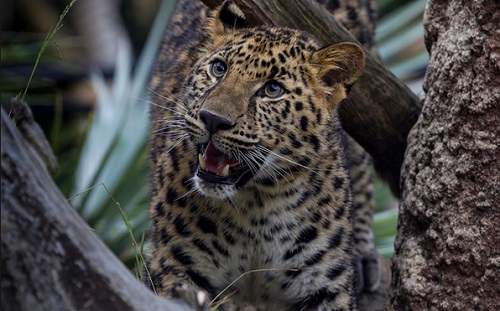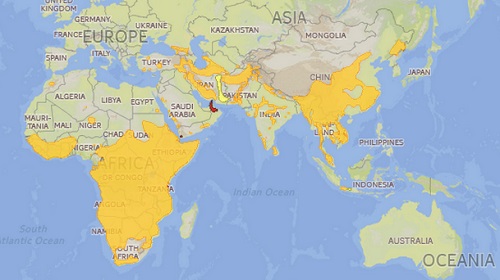Taxonomy
Kingdom |
Phylum |
Class |
Order |
Family |
Genus |
Species |
| Animalia | Chordata | Mammalia | Carnivora | Felidae | Panthera | Panthera pardus |
o

An Amur leopard from the San Diego Zoo. This sub species of leopard is considered Critically Endangered by the IUCN.
o
Name
- Scientific name: Panthera pardus. Panthera is derived from the Latin word panthera or the Greek word panther meaning “panther, leopard”. Pardus is derived from the Latin pardus or from the Greek pardos meaning “male panther”.
- Common name: Panther, Leopard. The word leopard comes from the Greek words leon meaning “lion” and pardos meaning “male panther”. Leopards were believed to be a hybrid of lion and panther.
Habitat
- Leopards have highly variable habitats. They live in rainforest, savannas, grasslands, woodlands, deserts, mountains, shrub forests and temperate forest.
- They have been found at altitudes of 18,500 feet (5,638 meters) above sea level.
Physical Features
- Coat color and body size fluctuate regionally reflecting adaptation to weather. The color of its coat varies from light yellow in warm and dry habitats to deep gold in dense forests.
- Its body is covered with dark spots called rosettes which can be of different shapes. Rosettes are circular in East Africa populations and square in southern Africa and some Asian populations.
- Black leopards are called black panthers. The color is due to a dark melanin color variant opposite to albinism.
- Each leopard has unique rosette patterns which make them easy to be identified by researches.
- Leopards are smaller than most members of the Panthera genus.
- Leopards have short legs relative to the size of its body and strong scapula muscles to help them climb.
- Tail measures from 24 to 43 in (60 to 110 cm).
Weight and Height
- Males are about 30% larger than females.
- Males weigh range from 68.3 to 143.3 lbs (31 to 65 kg) and their length from 5.25 to 7.5 ft (1.6 to 2.3 m) long.
- Females weigh range from 37.5 to 128 lbs (17 to 58 kg) and their length from 5.6 to 6.2 ft (1.7 to 1.9 m) long.
- The smallest leopard subspecies is the Arabian leopard (Panthera pardus nimr) that lives in the Arabian Peninsula.
- The largest leopard subspecies is the Persian leopard (Panthera pardus ciscaucasica) and inhabits the Caucasus, Iran and Turkmenistan.
Distribution
- African leopard (Panthera pardus pardus) – Africa
- Javan leopard (Panthera pardus melas) – Indonesian island of Java.
- Sri Lankan leopard (Panthera pardus kotiya) – Sri Lanka.
- Indian leopard (Panthera pardus fusca) – India.
- Arabian leopard (Panthera pardus nimr)– Arabian Peninsula.
- Indochinese leopard (Panthera pardus delacourii) – southern China to southeast Asia.
- North Chinese leopard (Panthera pardus japonensis) – northern China.
- Amur leopard (Panthera pardus orientalis) – Far East Russia, Korean Peninsula and north east China.
- Persian leopard (Panthera pardus ciscaucasica)– Caucasus, Iran and Turkmenistan.
- Leopards have the largest distribution of all wild cats.
Behavior
- Leopards are solitary animals.
- Leopards are very agile animals and strong swimmers and climbers.
- They can run at over 36 mph (58 km/hr), jump vertically up to 9.8 ft (3 m) and 20 ft (6 m) horizontally.
- They are territorial animals and mark their territory with scratches, urine and feces. Home ranges of males vary between 12 to 30 square miles (30 to 78 square kilometers) and of females from 5.8 to 6.2 square miles (15 to 16 square kilometers).
- Home ranges of males do not overlap but they do with those of females. Males are more tolerant of females as they have a higher chance of mating.
- They communicate with vocalizations such as roars, grunts, growls, mews and purrs
- When leopards hunt they move slowly towards its prey and suddenly ambush it before it has time to escape. The leopard breaks the prey’s neck and carries the carcass to a place where it can safely eat, leftovers are covered and saved for the future.
Diet
- These cats are carnivores and opportunistic predators. They eat a wide range of mammals, birds, reptiles and rodents.
Reproduction
- Females reach reproductive maturity at 2.5 years old and males at 2.
- They reproduce throughout the year but breeding peaks during the rainy season.
- Pregnant females build a den in a hollow tree, cave or a crevice where they give birth and spend the first few weeks with their cubs.
- Gestation lasts 96 days and litter size is 2 to 4.
- Breeding interval is from 15 to 24 months.
The Young
- Cubs are born with a weight of around 2.2 lb (1 kg).
- They drink their mother’s milk for the first 3 months and start eating solid food at 6 to 8 weeks old.
- They leave the den when they are 6 weeks old and start learning how to hunt and acquire the skills to survive on their own.
- They stay with their mother for 1.5 to 2 years after which they become independent.
- There is no paternal care.
- Cub mortality during the first year is estimated at 40 to 50% due to predation.
Life Expectancy
- In the wild leopards live up to 17 years.
- In captivity they live up to 27 years.
Predators
- Humans are the main predator of leopards.
- Leopards are not at the top of the food chain. They are at risk of predation by lions, tigers, wild dogs and spotted hyenas.
Threats
- Even though leopards have a large distribution and their populations are healthy in some parts of Africa and Asia, they are rapidly declining in other areas.
- Habitat loss and degradation due to human settlements and land conversions.
- Hunting and trade for fur, traditional rituals and medicinal purposes.
- Persecution for livestock loss and protection.
- Increasing conflict with people as leopards are somewhat tolerant of habitat conversion.
Conservation Status
- The leopard is listed as a Near Threatened species by the IUCN Red List of Threatened Species.
- It is listed in Appendix I of CITES.
- Leopards are protected by national laws in most of its distribution.
Did you know?
- Black panthers are black leopards in Africa and Asia. Black panthers are black jaguars in the Americas.
References and further research
IUCN Red List of Threatened Species – Panthera pardus
San Diego Zoo Library – Leopard, Panthera pardus
African Wildlife Foundation – Leopard
University of Michigan Museum of Zoology – Panthera pardus leopard
Panthera Wild Cat Conservation – Leopard
Google Scholar – Panthera pardus
Animal Aging and Longevity Database – An Age Entry for Panthera pardus

